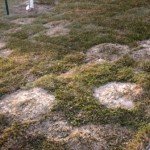Fungus Growing in Your Lawn? And We Don’t Mean Mushrooms…
 Along Colorado’s Front Range, snow mold may be more of an issue this year than in the recent past. Conditions have been ideal for this unsightly turf problem to develop.
Along Colorado’s Front Range, snow mold may be more of an issue this year than in the recent past. Conditions have been ideal for this unsightly turf problem to develop.
Turf damage shows up as circular patches of matted and straw-colored grass that appear dead. The patches may also be covered with gray or white webbing. Snow mold damage is unattractive and maybe, downright yukky.
What is it?
Snow mold is a fungus, commonly called “gray snow mold” that develops after 40-60 days of snow cover and when temps on the ground are around freezing. This is exactly how the winter and the snow have stacked up along the Front Range this season.
The dark, wet and matted conditions of the grass underneath snow piles that have not melted for a couple of months have been ideal for disease growth. Areas of deep snow such as where snow has been piled on top of the turf from shoveling or plowing will be most vulnerable. It is most prevalent in shaded areas such as the north sides of buildings.
When does damage appear?
After snow thaws, the damage will be seen in dead-looking patches of grass and the patches may grow to cover large areas of lawn. Affected areas of the lawn often take longer to green up in the spring leaving the lawn a checkerboard of green and brown.
What can you do about damaged lawns?
There is some good news in the snow mold scenario. While these dead patches of lawn will definitely be unsightly for a while, over the long term, they are more cosmetic than permanent. Rising temperatures will ultimately trump the fungus. Another plus for many property owners is that some of the most common Colorado lawns – Kentucky bluegrass and fine fescue – are the most resistant to this disease.
Still, there will be weeks ahead with dead-looking patches in the lawn and there are some things you can do to hasten its demise.
The number one recommendation from turf experts at Colorado State University is simply to rake the areas lightly with a leaf rake. Gentle raking helps open up the matted turf and promotes drying which helps prevent additional fungus growth.
Standard best care practices for a healthy lawn also apply. Aerate in early spring and fertilize in late spring. If there are areas of die back in the lawn, they can also be reseeded in the spring.
Treatments. Fungicides are not recommended because they have not proven effective. It’s better to let Mother Nature deal with the problem in due time by bringing warmer weather.
Steps to avoid snow mold
- To reduce long-lasting snow cover on lawns, avoid piling snow on the turf whenever possible during snow removal. Also avoid piling snow on lawns on north sides of buildings and other shaded areas.
- In the fall, mulch fallen leaves on top of the turf with a mower or rake/remove excess amounts of leaves. Non-mulched leaves left on the lawn will create a wet mat just as snow cover does and the fungus may also feed on the leaves.
Being rid of fungus-damaged lawns is another reason to be thankful to Mother Nature when she returns the warm days of spring.



